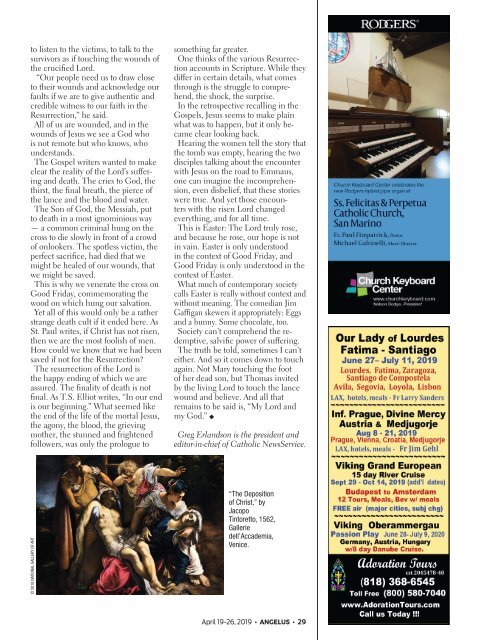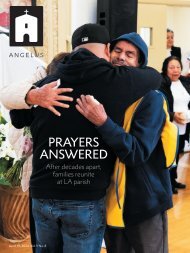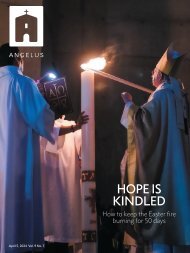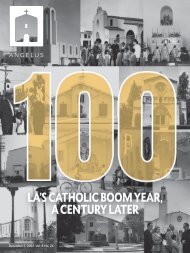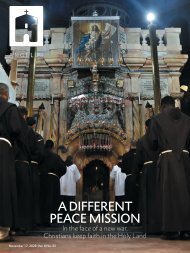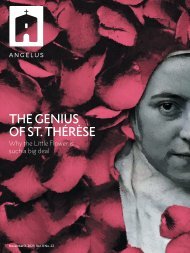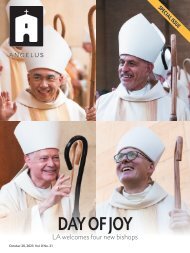Angelus News | April 19-26, 2019 | Vol. 4 No. 15
People hold candles during the Easter Vigil service at Westminster Cathedral on April 4, 2015, in London, England. Also known as the Paschal Vigil, the nocturnal liturgy celebrating the victory of Jesus Christ over death was for early Christians a night full of anticipation and dramatic symbols, rites, and singing. On page 10, contributing editor Mike Aquilina takes us back to the experience of the primitive Church to understand why the vigil was “the night of nights” for those Christians — and why it should still be for us, too. On page 16, Caitlin Yoshiko Kandil speaks to local catechumens about their road to conversion and why they’re looking forward to the “new life” of the baptism they’ll receive at this year’s Easter Vigil.
People hold candles during the Easter Vigil service at Westminster Cathedral on April 4, 2015, in London, England. Also known as the Paschal Vigil, the nocturnal liturgy celebrating the victory of Jesus Christ over death was for early Christians a night full of anticipation and dramatic symbols, rites, and singing. On page 10, contributing editor Mike Aquilina takes us back to the experience of the primitive Church to understand why the vigil was “the night of nights” for those Christians — and why it should still be for us, too. On page 16, Caitlin Yoshiko Kandil speaks to local catechumens about their road to conversion and why they’re looking forward to the “new life” of the baptism they’ll receive at this year’s Easter Vigil.
You also want an ePaper? Increase the reach of your titles
YUMPU automatically turns print PDFs into web optimized ePapers that Google loves.
to listen to the victims, to talk to the<br />
survivors as if touching the wounds of<br />
the crucified Lord.<br />
“Our people need us to draw close<br />
to their wounds and acknowledge our<br />
faults if we are to give authentic and<br />
credible witness to our faith in the<br />
Resurrection,” he said.<br />
All of us are wounded, and in the<br />
wounds of Jesus we see a God who<br />
is not remote but who knows, who<br />
understands.<br />
The Gospel writers wanted to make<br />
clear the reality of the Lord’s suffering<br />
and death. The cries to God, the<br />
thirst, the final breath, the pierce of<br />
the lance and the blood and water.<br />
The Son of God, the Messiah, put<br />
to death in a most ignominious way<br />
— a common criminal hung on the<br />
cross to die slowly in front of a crowd<br />
of onlookers. The spotless victim, the<br />
perfect sacrifice, had died that we<br />
might be healed of our wounds, that<br />
we might be saved.<br />
This is why we venerate the cross on<br />
Good Friday, commemorating the<br />
wood on which hung our salvation.<br />
Yet all of this would only be a rather<br />
strange death cult if it ended here. As<br />
St. Paul writes, if Christ has not risen,<br />
then we are the most foolish of men.<br />
How could we know that we had been<br />
saved if not for the Resurrection?<br />
The resurrection of the Lord is<br />
the happy ending of which we are<br />
assured. The finality of death is not<br />
final. As T.S. Elliot writes, “In our end<br />
is our beginning.” What seemed like<br />
the end of the life of the mortal Jesus,<br />
the agony, the blood, the grieving<br />
mother, the stunned and frightened<br />
followers, was only the prologue to<br />
something far greater.<br />
One thinks of the various Resurrection<br />
accounts in Scripture. While they<br />
differ in certain details, what comes<br />
through is the struggle to comprehend,<br />
the shock, the surprise.<br />
In the retrospective recalling in the<br />
Gospels, Jesus seems to make plain<br />
what was to happen, but it only became<br />
clear looking back.<br />
Hearing the women tell the story that<br />
the tomb was empty, hearing the two<br />
disciples talking about the encounter<br />
with Jesus on the road to Emmaus,<br />
one can imagine the incomprehension,<br />
even disbelief, that these stories<br />
were true. And yet those encounters<br />
with the risen Lord changed<br />
everything, and for all time.<br />
This is Easter: The Lord truly rose,<br />
and because he rose, our hope is not<br />
in vain. Easter is only understood<br />
in the context of Good Friday, and<br />
Good Friday is only understood in the<br />
context of Easter.<br />
What much of contemporary society<br />
calls Easter is really without context and<br />
without meaning. The comedian Jim<br />
Gaffigan skewers it appropriately: Eggs<br />
and a bunny. Some chocolate, too.<br />
Society can’t comprehend the redemptive,<br />
salvific power of suffering.<br />
The truth be told, sometimes I can’t<br />
either. And so it comes down to touch<br />
again. <strong>No</strong>t Mary touching the foot<br />
of her dead son, but Thomas invited<br />
by the living Lord to touch the lance<br />
wound and believe. And all that<br />
remains to be said is, “My Lord and<br />
my God.” <br />
Greg Erlandson is the president and<br />
editor-in-chief of Catholic <strong>News</strong>Service.<br />
© 2018 NATIONAL GALLERY OF ART<br />
“The Deposition<br />
of Christ,” by<br />
Jacopo<br />
Tintoretto, <strong>15</strong>62,<br />
Gallerie<br />
dell’Accademia,<br />
Venice.<br />
<strong>April</strong> <strong>19</strong>-<strong>26</strong>, 20<strong>19</strong> • ANGELUS • 29


